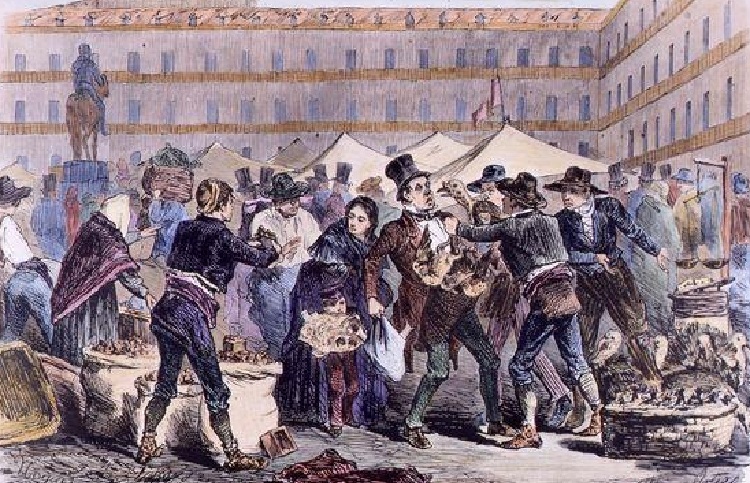Eduardo González
The Madrid’s Plaza Mayor has hosted for more than a century and a half one of the most popular Christmas markets in Spain and most attractive for international tourism.
The history of our square began in the mid-fourteenth century, when the King of Castile Henry IV authorized the first franc market in Madrid. For this purpose, two scenarios were chosen, one within the walls, the Plaza de San Salvador (the current Plaza de la Villa), and another outside the walls, the Plaza del Arrabal, located in an esplanade of cars in which converged merchants and goods from the roads of Toledo and Atocha.
The next important chapter in this history took place in 1580, when Felipe II commissioned Juan de Herrera (the architect of the Monastery of El Escorial) with an ambitious urban plan to ennoble the appearance of the Villa, which he himself had converted into the seat of the Court in 1561.
At that point, the Plaza del Arrabal had already displaced San Salvador as the main market square in Madrid, but its real start came in 1619, just four hundred years ago, when – in the midst of the reign of Felipe III and under the master hand of Juan Gómez de Mora- the remodelling work on the Plaza Mayor, the new popular name for the Plaza del Arrabal, was completed. Thanks to these works, framed in the aforementioned urban plan of Felipe II, Madrid had just been provided with a sufficiently ample place to install the weekly market and to celebrate all kinds of social events, such as carnival battles, bullfights, acts of faith of the Inquisition and even public executions on the municipal gallows.
It was also in the seventeenth century when it began to operate in its neighboring Plaza de Santa Cruz, opposite the current headquarters of the Ministry of Foreign Affairs, a Christmas market which sold food (meat, vegetables or fruit), animals (turkeys and live chickens, especially), flowers, ornaments and gifts.
Over the years, the market gradually spread to the Cavas, Puerta Cerrada, Calle de Toledo, Calle del Arenal and, of course, the Plaza Mayor itself, as collected in 1765 by the playwright Ramón de la Cruz, one of the fathers of Madrid’s casticism, in his sainete La Plaza Mayor for Christmas. The success of the market was such that the authorities decided to bring order and, in the process, make some economic profit. In the nineteenth century, the City Council issued a regulatory regulation that required all Christmas merchants to apply for their license to sell after paying a fee of five pesetas for “each square meter or fraction in the Plaza Mayor, Ciudad Rodrigo street, Zaragoza and Plaza de Santa Cruz”.
In 1860, the City Council definitively moved the Christmas market to the Plaza Mayor. Since then, and especially since the beginning of the 20th century, the merchants of the square began to incorporate new products to their stalls, from nougat and marzipan to zambombas and jokes and, of course, figures of the Bethlehem and Christmas trees. After the forced recess of the Civil War, the Madrid City Council prohibited in 1944 the continued sale of food products in the Plaza Mayor and ordered that the stands be limited to jokes and Christmas decorations.
In 1962, the Plaza Mayor Christmas market became especially popular throughout Spain thanks to the film The Big Family, in which a desperate grandfather (Pepe Isbert) lost his youngest grandson, Chencho, in the middle of the crowd. The story ended happily and the phrase “Chencho, my son” became a reference of popular culture.
At present, the market brings together a hundred wooden houses (since the eighties, when the awning ones were replaced), managed by fifty families and under the organization of the Association of the Christmas Market of the Plaza Mayor.






